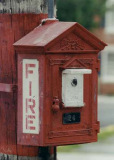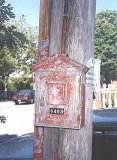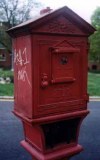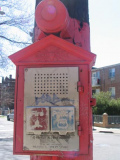The familiar red fire alarm box that has been a fixture on every other street corner in New York City is being phased out, with many of them being disconnected in many neighborhoods. The city has decided that calling 911 on a cellphone is the best response when a fire breaks out. The Fire Department of New York has complained that over 90% of the calls they receive from the fire boxes are false alarms. The removal or deactivation of fire alarms has continued apace. There were, when this page was written in 1999, a total of approximately 4400 remaining pull boxes (see below) and 9060 Emergency Rescue Service boxes (the ones with the buttons to contact the FDNY or the NYPD). None of the older pull boxes remain in Manhattan or the Bronx.
It’s interesting to note, though, that many fire alarms, and the lights that mark their presence, are functional “living fossils” as far as ‘street furniture’ goes. Many of the fixtures were installed in the first few years of this century.
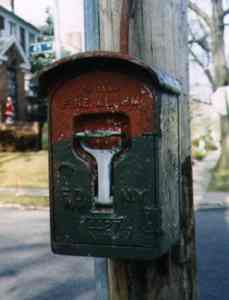
A typical fire alarm box with a handle. Every manual pull box sends a coded signal of the box number to the Central Office in the boro in which the box is located; then the dispatchers send the alarm to the appropriate firehouse. More recent models (Emergency Rescue Service) feature a speaker in which the caller can alert police or firemen. Some of the pull boxes have been in use since 1870 and, with modifications, are still in use today.

This is the prototypical NYC fire alarm, that has a lit torch sculpture at its apex that I always thought resembled a red ice cream cone, on Liberty Avenue in Ozone Park
A rare two-light NYC stoplight is in the background. These were made by the Ruleta Company in the early 20th Century. The stoplight has since been replaced.
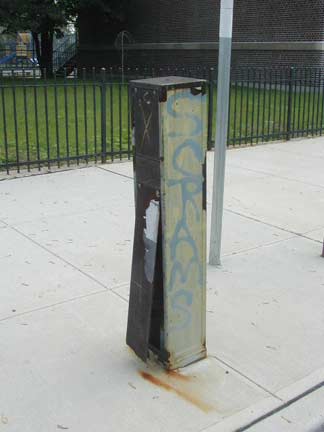
This is the boxier 1960s fire box design.Since it was abandoned by the city, it was a target for local youth.
While most standalone fire alarm boxes in NYC boast either a decorative torch at their apexes that resembles an ice cream cone, or are rectangular in shape, there are exceptions produced by the Gamewell Company that have peaked tops. a few of these are still around in Queens.
This is a standard issue fire box in Auburndale, Queens, but it’s got a very old public service ad on it. How old? Well, it’s signed Edward Thompson, Fire Commissioner (invisible on this scan.) Thompson was in office between 1962 and 1965. Foxy The Firefighter (found in Rosedale) probably came along a little later than the 1965 ad.
Over the years, the city has devised several methods to mark fire alarm boxes. In the early years, beginning in the 1910s, boxes were marked by large, orange globe-shaped diffusers, made of glass at the start and then plastic later on. They could be installed on the shafts of cast iron lampposts or on the arms of lights hung from utility poles. They could also be mounted directly on top of the main diffuser.
This became impractical, though, when mercury bulbs appeared and new diffusers started appearing in the early Sixties. The shape of the fire alarm diffuser changed from a globe to the tube-shaped object shown above. As a rule, the new fire alarm lamps were mounted on short, simple curved bars that were attached to the utility pole or lamppost shaft.
In certain sections of the city, however, the cast-iron arms shown above were retained to carry the fire alarm lights. These arms, with their distinctive ironwork, were originally used to carry street lighting on side streets in the days when a single incandescent bulb was needed to light the street, in the early part of this century. The one on top is the one most commonly seen, but the one below, which looks like its little brother, is much rarer.
Some of the streetlamps around town, in Coney Island, Borough Park and Canarsie feature an unusual combination. The bracket holding the fire alarm light at the right was generally used to hold the light on cast iron poles in the early part of the century when the bulb was globe-shaped. For whatever reason, a couple of them have wound up on the modern aluminum poles on the boardwalk.
(The ones at Coney Island have been replaced)
This specialized lamppost, used only in the private Forest Hills neighborhood of Queens, wears an orange fire alarm light. This is the only such pole I’ve seen.
The above two fire alarms, at Park and 34th (left) and Riis Park, Queens (right) are unusual in that they carry their own orange fire alarm lights. This used to be a rather more common arrangement, but it was found more convenient to mount them on lampposts and telephone poles instead.
In 2003 a new species of fire alarm light began to appear. They fastened to the top of the luminaire and glowed red both night and day. The City is phasing out the old orange cylinder lights. This post still has both varieties.
This now-disused alarm on 8th Avenue had a bell or klaxon attached. The pole has been stucco-painted to discourage note-pasters and graffitists.
In the early 20th Century fire alarm posts were often attached to the bases of lampposts. Note the old wide fire hydrant; this type was phased out in the 1990s. photo: Bob Mulero
This 1916 photo taken on Avenue C shows an old-style fire alarm with a lamp affixed on the top post.
3/14/1999
